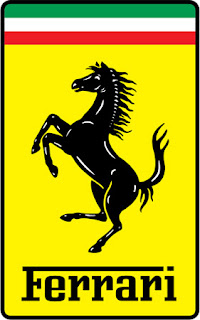No history of Ferrari is complete without mentioning that Enzo Ferrari worked for Alfa Romeo from 1920 to 1929 (he wanted to get a job at Fiat after WWI, but restrictions on civilian auto traffic in Italy meant the company wasn't hiring), and that he raced Alfas for another 10 years after that. From the time he was 12, according to Ferrari: The Man and His Machines, Enzo knew he wanted be a race driver. At Alfa, he achieved that dream, and adopted the cavallino, or prancing horse, insignia for his Alfa race car. In 1929, he left Alfa to start Scuderia Ferrari in Modena, his privately owned Alfa Romeo racing team.
The 1930s - Scuderia Ferrari:
In 1929, Enzo Ferrari left Alfa Romeo's employment to start his own racing stable (scuderia in Italian). Scuderia Ferrari did not race cars with the Ferrari name, though the Alfas they used on the track did sport the prancing horse. Race cars came to the scuderia from Alfa for tuning for almost a decade, and the Ferrari shop in Modena built its first car, the Alfa Romeo 158 Grand Prix racer, in 1937. In 1938, Alfa took its racing program in-house, and Enzo Ferrari went with it. After 10 years on his own, though, working for someone else proved difficult. He left Alfa (or was dismissed) for the last time in 1939.
The 1940s - Ferrari Survives the War:
When Enzo Ferrari left Alfa Romeo, he agreed to not use his name in connection with racing for four years. That wasn't so bad; WWII curtailed racing for most of those four years anyway. Ferrari moved from Modena to Maranello during the war, where it remains today. In 1945, Ferrari began work on the 12-cylinder engine the company would be famous for, and in 1947, Enzo Ferrari drove the first 125 S out of the factory gates. Post-war racing was Ferrari's finest hour on the track. Driver Luigi Chinetti was the first to import Ferrari cars to the U.S. in the late 1940s, including the first highway Ferrari, the 166 Inter.
The 1950s - Race- and Road-Ready:
During the 1950s, Ferrari had legendary engineers like Lampredi and Jano on the payroll, and bodies designed by the legendary Pinin Farina. Every time a race car was improved, the road car was the beneficiary. In 1951, a Ferrari 375 brought the team its first victory -- over Alfa Romeo, no less. The 357 America hit the market in 1953, as did the first in the long line of 250 GTs. Production of all Ferrari cars grew from 70 or 80 a year in 1950 to more than 300 by 1960. Enzo suffered a personal tragedy in 1956, when his son Dino, who had helped develop Ferrari's V6 engine, died of muscular dystrophy at the age of 24.
The 1960s - Turbulent Times :
The '60s started out pretty good for Ferrari: Phil Hill won the Formula 1 championship in 1961 using a 1.5-liter V6 race car nicknamed "Dino." It was the era of the sexy, swooping 250 Testa Rossa. But things got rough for the Prancing Horse, like when Carroll Shelby brought his Cobra to European race tracks. After years of rivalry, the Texan beat the Italian in 1964. Ferrari was having financial troubles as well, but that was nothing new. There were talks with Ford about a buyout, but Enzo Ferrari instead walked out on that deal and sold part of the company to Fiat in 1969.
The 1970s - What Gas Crisis? :
The V6 engine made it to a production model in the Dino 246 of the early '70s. In 1972, the company built the Fiorano test circuit next to the factory. Ferrari introduced the Berlinetta Boxer flat-12 engine to the world at the 1971 Turin Motor Show in the 365 GT/4 Berlinetta Boxer, and the car hit showrooms in 1976. The next year, Carozzeria Scaglietti di Modena, Ferrari's design house, was officially incorporated into the company. Cars were churned out, by Ferrari standards, with some models being built in the thousands. But the '70s ended on an odd note with the introduction of the automatic--but still V12--400i.
The 1980s - Greed Is Good -- for Ferrari:
Let's skip to 1985, when one of the most iconic of all Ferraris appeared on posters across the world: the Testarossa (note that this time, the model name is one word, not two). The '80s also saw the convertible Mondial and the realization of Enzo Ferrari's dream, the F40. It was built to commemorate the company's 40th anniversary, with a carbon-fiber body, a giant wing, and Kevlar panels. Ferrari's brand recognition was at an all-time high, with a (replica) 1961 250 GT starring in Ferris Bueller's Day Off. But in 1988, Enzo Ferrari died, at the age of 90. Fiat's share of Ferrari rose to 90%, and son Piero became VP.
The 1990s to Current - A New Era:
In 1991, Luca di Montezemolo took the reins of the Prancing Horse. The supercar streak continued with the F50, but the '90s had a wider offering of smaller engines, like the V8 in the F355 series. There were still V12s to be had, of course, like the Testarossas that continued to be built through the mid-90s. In 2003, Enzo Ferrari got his due, with a 230-mph supercar named for the company's founder. On the track, the hot-blooded Ferrari cars met their match in the cool German driving of Michael Schumacher, who raced Ferraris to seven F1 championships between 1994 and 2004.
Source: http://exoticcars.about.com














0 yorum:
Post a Comment